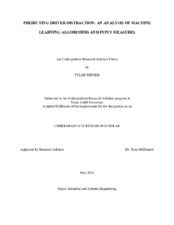| dc.description.abstract | The research area on the detection and classification of distracted driving is growing in importance as in-vehicle information systems such as navigation and entertainment displays, which introduce sources of distraction for drivers, become more common in vehicles. To mitigate the potential consequences of distracted driving it is necessary for such systems to provide a means of detecting driver distraction and then responding appropriately. This study uses a machine-learning approach to develop classification models that detect and differentiate both cognitive and sensorimotor distraction among drivers, which were induced via secondary tasks in a simulator study. The inputs to these models are combinations of driving performance measures (e.g. brake force, lane offset, speed, and steering angle) and driver physiological measures (e.g. breathing rate, heart rate, and perinasal electrodermal activity), and the outputs are predictions of driver distraction (e.g. cognitive distraction, sensorimotor distraction, or normal driving). Various combinations of driving performance and driver physiological measures, multiple types of machine-learning algorithms, and a systematic feature extraction and reduction method called TSFRESH were used to develop the classification models. Results showed that the physiological measures did not provide significant information for detecting and classifying driver distraction. Furthermore, no significant differences were found between the different machine-learning algorithms. Analyses on feature importance also revealed that driving performance measures including steering angle, lane offset, and speed were the most important indicators of distracted driving, and that features characterizing the extreme values, the variance and fluctuation, and the non linearity and complexity of time series input were more informative for classifying driver distraction than other features. Conclusions suggest that distraction detection models gain more information from driving performance measures than physiological measures and that using features that characterize specific aspects of time series input is useful for classifying driver distraction. | en |


